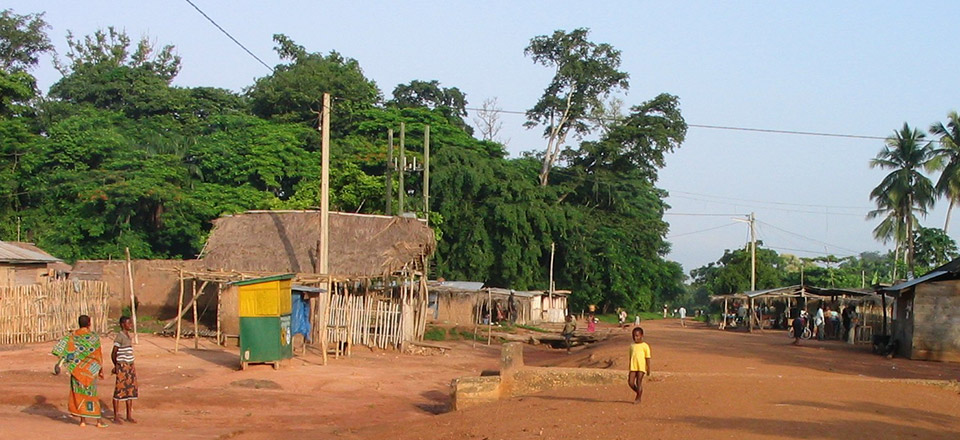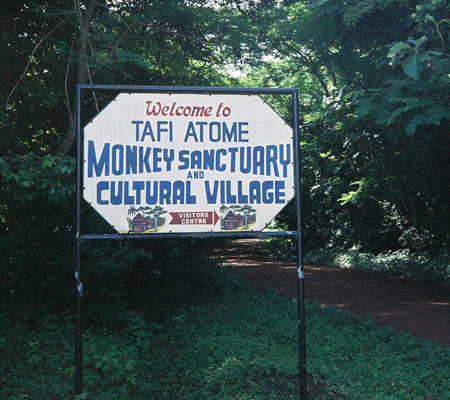Satul de Tafi Atome are peste 1000 locuitori şi este situat în districtul Hohoe a regiunii Volta de Ghana. Locuitorii vorbesc ovine. Satul este înconjurat de o grămadă sacră de aproximativ 28 are. Grove este o pădure semi-decenită și se află în zona de tranziție a pădurii-savannah. Este imediat înconjurat de pășuni și terenuri agricole cultivate. Grove se încadrează în IUCN zona protejată Categoria IV, un habitat și / sau zona de gestionare a speciilor. Zona este protejat de o 2006 Hohoe District regulamentul intern pentru valoarea ei principal ca habitat pentru sacre mona maimuțe (Cercopithecus mona mona).
Potrivit locuitorilor, aproximativ 200 de ani în urmă, strămoșii locuitorilor din zona Tafi Atome se spune că au migrat de la Assini în Ghana centrală a District Hohoe. Ei au adus cu ei un idol sau fetiș care a fost plasat în pădure sacru în Tafi Atome, în scopul de a păstra în siguranță și rece. Pădure a fost considerat imediat sacru și, prin urmare, protejate. La scurt timp după sosirea lor în zonă, Locuitorii satului au început să observe maimuțe pe care credeau că le -au văzut în regiunea lor originală din Assini, și, prin urmare, credeau că maimuțele le -au urmat. Maimuțele erau de acum considerate „reprezentanți ai zeilor”, și protejat ca sacru.
În anii 1980, un lider creștin local, a adus puncte de vedere opuse legii tradiționale, care a dus la deteriorarea de conexiuni spirituale cu pădure fetiș și eroziunea de protecție tradiționale. Locuitorii taie copaci viabile economic, în special în jurul Crângul Sacru, până la o organizație de mediu ajutat re-afirma protecție a crâng în 1990. Există o presiune continuă de la localnici pentru a șterge pădurilor pentru terenuri agricole și să taie copaci. Există, de asemenea, presiune turistică pentru a hrăni maimuțele Mona.
Amenintat, Există o presiune continuă din partea locuitorilor locali pentru a curăța pădurile pentru terenurile agricole.
Coaliţie
Comunitatea, inclusiv comitetul de gestionare a turismului, Lucrează cu organizații, inclusiv Centrul de Cercetare pentru Conservarea Naturii (NCRC) să urmărească turismul pentru a păstra patrimoniul natural și cultural al Sacred Grove.
Acţiune
În 1995, Centrul de cercetare a conservării naturii bazat pe Accra a vizitat satul Tafi Atome și a găsit pădurea sacră într-o stare de degradare. În 1996, Un proiect de ecoturism bazat pe comunitate a fost început în sat. În 1997, Copacii de mahon au fost plantați pentru a demarca limita sanctuarului pentru a opri viitoarea înfrângere a terenurilor agricole pe marginea pădurii.
1n 1998, Un centru de bun venit turistic a fost construit pentru a servi drept primul punct de contact pentru turiștii care sosesc în sat. A fost finanțat de comunitate și de donatori externi.
Opinia sătenilor a fost evaluată în sondajele dintre 2004 şi 2006.
Instrumente de conservare
Menționați instrumentele sau abordările de conservare care au fost utilizate sau dezvoltate pentru a sprijini lucrările pe site -urile naturale sacre. Acestea pot fi instrumente sau metode utilizate pentru inventarul sau monitorizarea plantelor și animalelor sau pentru dezvoltarea capacității comunității și consolidarea valorilor culturale ale Site -ului și ale oamenilor săi. Ar trebui menționată și utilizarea instrumentelor și orientărilor de planificare, De exemplu, ghidurile de situri naturale sacre UNICN UNESCO pentru managerii de zonă protejată de către Wild și McLeod.
Descrieți cele mai importante politici și lege care susțin sau împiedică conservarea siturilor și speciilor naturale sacre. În 2006, Districtul Hohoe a trecut de statutele oficiale, inclusiv restricții pentru a intra în sanctuarul pădurilor, pentru a deteriora copacii, a face fermă în zona protejată, sau pentru a ucide animale în grădină.
Rezultate
Membrii comunității participând la 2004 şi 2006 Sondajele au spus că valorile culturale ale comunității s -au îmbunătățit ca urmare a promovării turismului. Sosirea turiștilor a adus și venituri din turism, care este distribuit între părțile interesate (e.g. preot fetiș, șefi) și folosit pentru dezvoltarea comunității, Compensare pentru proprietarii de terenuri din Sanctuar, și fonduri educaționale.
- Ormsby A și Edelman, C. (2010) Bazate pe comunitate de Ecoturism la Tafi Atome Monkey Sanctuary, un loc natural sacru în Ghana , În Verschuuren B., Wild R., McNeely JA. și Oviedo G. (EDS) "Sacred Site-uri naturale : Conservarea naturii și a culturii ”Scanarea Pământului, Londra.
- Centrul de cercetare a conservării naturii (NCRC), Ghana: Vizitati site-ul
- NTIAMOA-BAIDU, Y.. (1995) Indigene vs. A introdus strategii de conservare a biodiversității: Cazul sistemelor de zonă protejată în Ghana, Seria biodiversității africane, 1, Program de asistență pentru biodiversitate, Washington DC: Vizitati site-ul
- Ormsby, A. 2012. Percepțiile turismului la Sacred Groves din Ghana și India. Rasaala: Recreere și societate în Africa, Asia și America Latină 3(1): 1-18.
- Ormsby, A. 2012. Valorile culturale și de conservare ale pădurilor sacre din Ghana. p. 335-350 În Pungetti, G., G. Oviedo și d. Hooke (eds.) Specii sacre şi Site-uri: Advances in Conservation Biocultural. Cambridge: Cambridge University Press. Obțineți publicația






